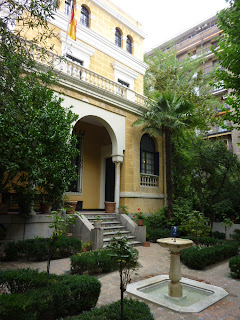Allow me to confess at the outset that I'm a fan of Spanish painter Joaquín Sorolla y Bastida (1863-1923).
So the morning after arrival in Madrid last month -- before visiting the Prado, Thyssen, Sofia and other well-known art museums -- I hightailed it to the Museo Sorolla, the former home of the artist.
Getting there is fairly easy, provided one is willing to take public transit. (From the Plaza Puerto del Sol, the walk is no less than a mile and a quarter; this can be a serious project on a hot summer day.) Get on or connect with the No. 10 Metro line and exit at Gregorio Marañón station. Then walk two blocks south on the Calle Miguel Angel and turn right onto Paseo General Martínez Campos, a street with mid-rise post-1960 structures. A short distance along the north side is a wall, behind which is the Sorolla house/museum, completed in 1911.
Before entering, one must pass through a garden.
That's the entry. To the right once you enter is a desk where you pay for your visit and buy publications (most or all in Spanish); they will give you a free English-language museum guide.
Looking down on a hall area. The house is laden with objets d'art, as can be seen in this and following photos. These were present when Sorolla lived here.
The dining room.
The living room.
Sorolla's studio as seen from above.
The studio from floor-level.
Another general view of the studio. Note the covered bed at the right. Sorolla was driven to paint. Apparently this compulsion required that at times he wanted to sleep close to his work so as to get back in action as quickly as possible without disturbing others in the household.
The scene set, let's look at his work setup at the time in 1920 when he suffered a debilitating stroke.
Another view, this in high resolution: click to enlarge.
Sorolla's paintbox and palettes.
Sorolla's smaller palette.
A high-resolution view. Click to enlarge.
Sorolla worked rapidly. He left a number of small oil sketches that probably mostly served as notes from the field. Early in his career he produced works that were relatively "tight" and "finished" in the academic tradition. But his better-known later works, aside from some portraits, were large and painted freely. These and the sketches allow us to understand his methods to some degree.
What is rare are clearly unfinished paintings. Fortunately, the museum has an example of a study made as part of his Regions of Spain commission. Part of the work is "complete" (insofar as Sorolla "finished" his later works). Other parts reveal preliminary on-canvas oil sketching of a person.
Snapping digital photos in museums is usually easy, but getting good high-resolution results is a tricky business. When you glance at a preview image on that tiny camera screen it may seem just fine; but loaded into your computer and viewed, the results are often blurred and stray lighting not noticeable to the naked eye in the gallery can become apparent.
Nothing can be done about odd lighting effects; that's largely beyond your control at the time you're taking the picture. Blurred or out-of-focus results can be tamed to some degree, but not entirely.
One problem is that painted images are not always crisp, making it difficult for camera automatic-focusing software to be sure what the correct focus should be. Expensive, manual-focus cameras can avoid this problem, but those of us with a sub-$800 camera budget are in a pickle in this regard.
In many cases it's not possible to get close to the target area of a painting, so the photographer must zoom in close. In telephoto mode, focusing must be precise. But as I just mentioned, this can be hard to do. Another problem in telephoto is holding the camera steady -- movement is exaggerated in telephoto mode (and some museums don't allow use of a tripod, a helpful device).
Wide-angle photography entails greater depth of field (focus zone) than telephoto, but there are problems here too. One is that too much wide-angle creates distortion. Another is that the photographer has to get close to the part of the canvas that he's interested in if he needs plenty of high-res detail -- but, as noted, often one can't get as near as one would like.
All this is a kind of excuse/apology/rationalization for the spotty quality of the high resolution photos shown below that are intended to provide insights regarding Sorolla's color selection and brushwork. These photos are not as good as I intended, but they're what I took when I was on-site. So take a look and click to enlarge if you're interested and your computer allows it.
Detail of Trata los blancas 1894.
Detail of self-portrait, 1912.
Detail of Clotilde con traje de noche, 1910.
Detail of another portrait of Clotilde.
Detail of Clotilde en la playa, 1904.
Detail of La bata rosa, 1916.
Detail of woman with mantilla.
Detail of Bajo el toldo, playa de Zarauz, 1910
Detail of Cordeleros de Jávea, 1898.
Detail of painting with three women.
Sorolla's work can be found here and there in the United States, but the largest concentration is at the Hispanic Society in New York City, a site that I, alas, have yet to visit.



























